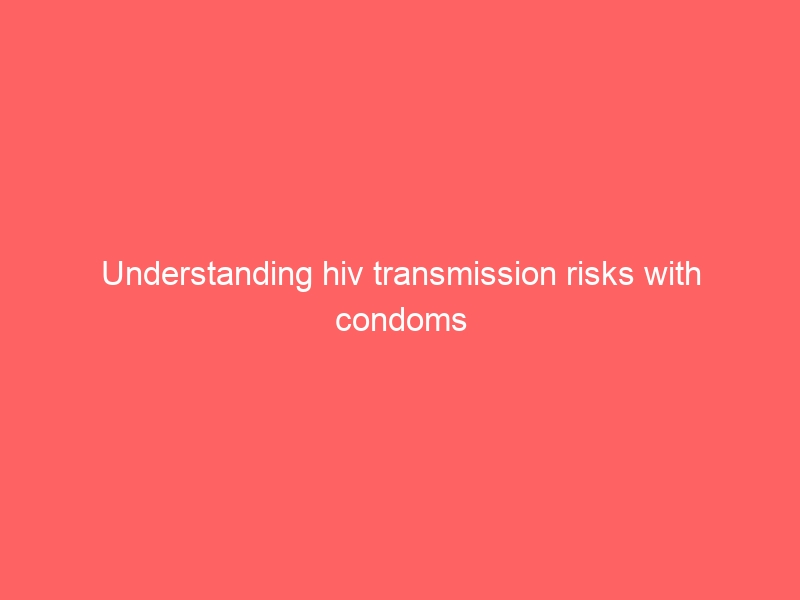When it comes to protecting ourselves from HIV, understanding the role of condoms is crucial. We often hear questions like, "can HIV pass condom?" and it’s important for us to clear up any confusion. By using condoms correctly, we can significantly reduce the risk of transmission. In this article, we’ll explore the various types of condoms, how they work, and address common misconceptions that may exist. Together, we’ll learn best practices for proper condom use and discover additional methods for safer sex.
The Importance of Condom Use in HIV Prevention
We’re aware that using condoms significantly reduces the risk of HIV transmission. We’ve seen how effective they are in protecting against not just HIV, but other sexually transmitted infections too. When we prioritize condom use, we’re taking an essential step towards safer sex practices. It’s important for us to communicate openly with our partners about this. Together, we can foster a culture of safety and responsibility.
Types of Condoms and Their Effectiveness
Different types of condoms can significantly impact our protection against HIV transmission, and knowing their effectiveness helps us make informed choices. We’ve got latex condoms, which are highly effective when used correctly. Polyurethane condoms are another option, and they can be beneficial for those with latex allergies. We should also consider polyisoprene condoms, as they offer similar protection without the latex. It’s crucial for us to choose the right type to ensure maximum safety.
How Condoms Prevent HIV Transmission
Condoms significantly reduce the risk of HIV transmission during sexual activities, and they’re an essential tool for safer sex. They create a barrier that prevents the exchange of bodily fluids, which is crucial in reducing transmission. By using condoms consistently and correctly, we can protect ourselves and our partners from potential infection. It’s important for us to communicate openly about condom use to ensure everyone’s safety. Together, we can promote healthier sexual practices and reduce the spread of HIV.
Common Misconceptions About Condom Use
Many people believe that using condoms guarantees complete protection against HIV, but that’s not always the case. We often overlook the possibility of condom breakage or slippage during intercourse. Some folks think that using two condoms provides extra safety, but that can actually increase the risk of tearing. We also tend to forget that condoms don’t protect against all types of sexual contact, like oral sex. It’s essential for us to stay informed and understand that while condoms greatly reduce risk, they’re not infallible.
Best Practices for Proper Condom Use
Proper condom use is essential for maximizing protection against HIV transmission, and we’ve got to make sure we’re following the best practices. We should always check the expiration date before using a condom. It’s important to store them in a cool, dry place to prevent damage. When putting on a condom, we need to ensure there’s no air trapped at the tip. Lastly, we’ve got to use water-based or silicone-based lubricants to reduce the risk of breakage.
Additional Methods for Safer Sex
Exploring additional methods for safer sex can enhance our overall protection and reduce the risks of HIV transmission. We’ve gotta consider regular testing as a crucial part of our strategy. Using dental dams during oral sex can also help minimize exposure. Limiting the number of sexual partners can further decrease our risk. Lastly, open communication about our sexual health with partners strengthens our safety measures.
Conclusion
In conclusion, embracing condom use is a vital step we can take to protect ourselves and our partners from HIV and other STIs. By understanding the different types of condoms and their proper use, we can make informed choices that enhance our safety. It’s essential to communicate openly about our sexual health and practices, as this fosters a culture of responsibility. While condoms significantly reduce risks, we must remember they aren’t foolproof, so regular testing and awareness are equally important. Together, we can create a safer environment for ourselves and those we care about.
For those looking to deepen their understanding of safe sex practices, particularly regarding HIV transmission risks, I highly recommend visiting this informative page on Trojan condoms: Are Trojan Condoms Reservoir or Plain?. It provides valuable insights that can help you make informed choices about condom use and sexual health.
